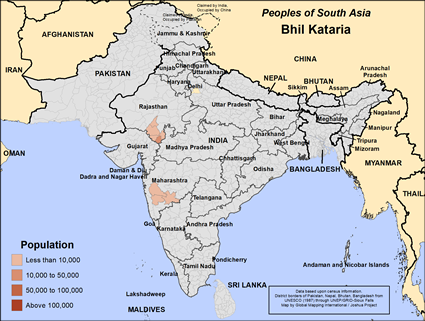There are two divisions of Bhil: the Central or "pure" Bhil, and the Eastern or part-Rajput Bhil. The Central Bhil live in the mountain regions of India, particularly in the states of Madhya Pradesh, Gujarat, and Rajasthan. They are known as the connecting link between the Gujarati and the Rajasthani. They speak Bhili, which is an Indo-Aryan language.
Many years ago, Bhil rajas (kings) permitted immigrants from the plains to settle in the hill regions. To safeguard their independence and rule, the Bhil fought against the Moghals, the Maratha and the British Raj.
The Kataria Bhil people have always been experts in handling bows and arrows. In fact, the name "Bhil" was derived from the word billee, which means "bow." For years, the bow has been a characteristic weapon of the tribe, and the men usually carry their bows and arrows with them. They are known for their rugged independence, but also for their banditry.
The Kataria Bhil people live mainly in Rajasthan and Maharashtra.
Many Bhil are being threatened by the Sardar Saravor Dam Project, which when completed will flood the land where many Bhil currently live. Though re-settlement plans have been discussed, they remain incomplete.
Today, the Kataria Bhil primarily work as farmers, field laborers and village watchmen. With a growth in population, most of their land holdings are small and generally non-productive. The women wear brightly colored clothes. The city boys are distinctive from other Hindus because they tie rags around their heads, wear earrings, and carry swords or guns.
The Kataria Bhil are usually shy and love their independence. Festivals, dance, drama, and music are a large part of their culture. The length and enthusiasm for these events is usually directly proportional to the amount of alcohol that is consumed.
The Kataria Bhil usually marry within their own classes. If they do marry someone of another class, the person of the lower class must convert to the higher, leaving behind all family ties. This custom is strictly enforced among the Bhil tribes.
Each Kataria Bhil village is led by a head man who deals with disputes. Respect among family members is strong, and there is a great sense of connection between the living and the dead. Property is shared equally by the male descendants. Bhil villages are rather widely scattered. The houses are located in fields where they grow millet, maize, wheat, and barley. Bhil highlanders live in tidy houses made with walls of sticks intertwined with small branches. The roofs (shaped like bee-hives), are usually made of clay tiles, but are sometimes made of straw and leaves.
Almost all of the Kataria Bhil practice ethnic religions that have been highly influenced by Hinduism. They consider Shiva to be the supreme god. Ancestor worship (praying to deceased ancestors) is also popular. They call upon shamans (priests) to offer sacrifices to their many gods and mud idols.
Much intercession is needed to see Kataria Bhil eyes opened to the truth.
Pray for his kingdom to come and his will to be done among the Kataria Bhil people.
Pray for a movement of Kataria Bhil households to study the Bible and accept the blessings of Christ.
Pray for a spiritual hunger that will drive the Kataria Bhil people to the arms of Jesus.
Pray for workers who are filled with the fruit and the power of the Holy Spirit to go to the Kataria Bhil people.
Scripture Prayers for the Bhil Kataria in India.
https://joshuaproject.net/people_groups/16414/IN
https://www.britannica.com/topic/Bhil
https://en.wikipedia.org/wiki/Bhil_Kataria
http://www.ecoindia.com/tribes/bhils.html
https://en.wikipedia.org/wiki/Bhil_people
http://www.indianmirror.com/tribes/bhiltribe.html
| Profile Source: Keith Carey |











